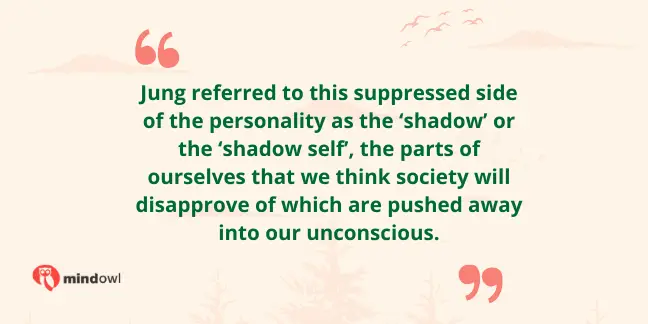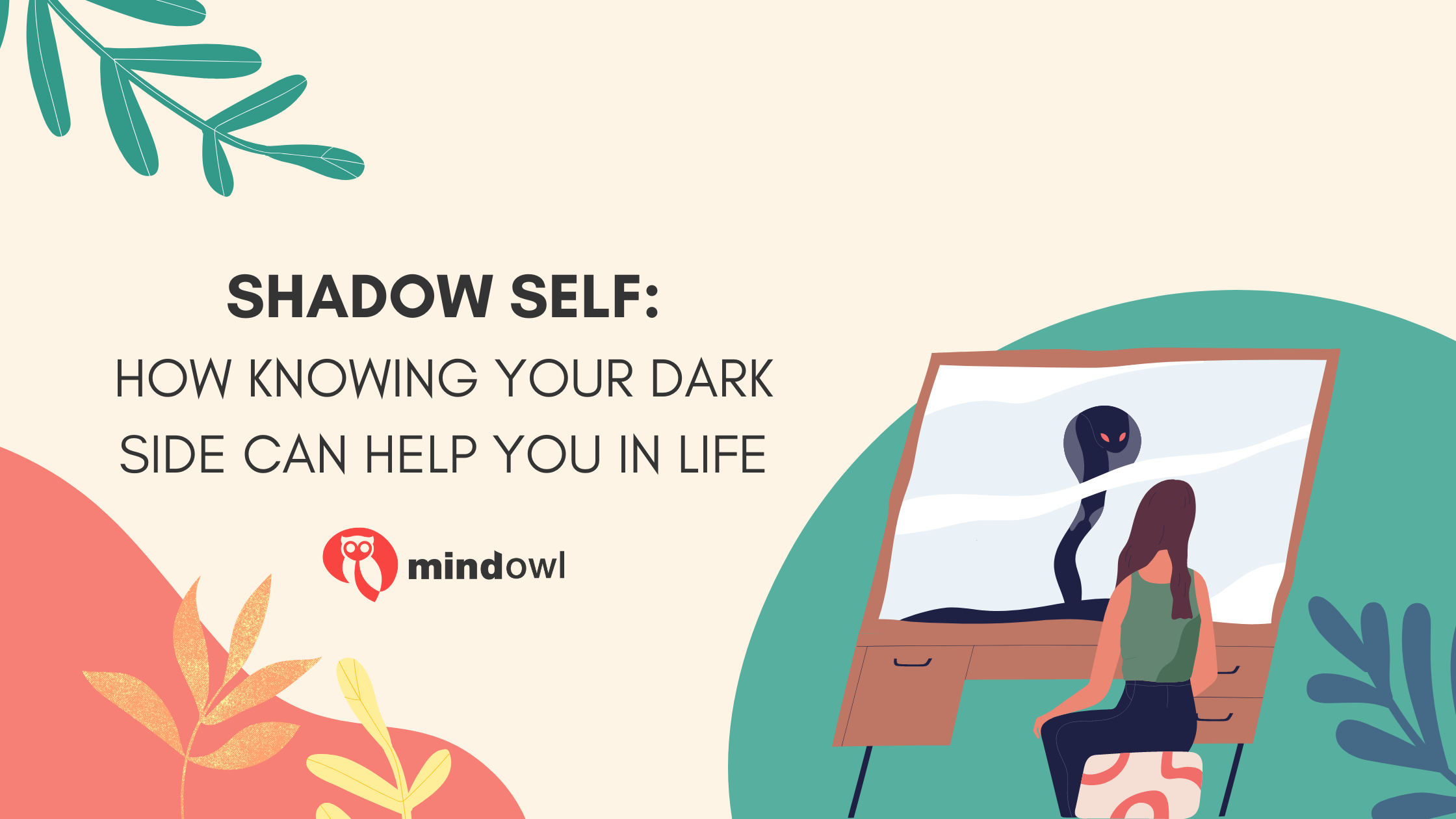Psychologist Carl Jung stated that integrating your shadow can lead to a more fulfilling life. But what is the shadow self? How do we identify it? Let’s take a look.
What is the shadow self? Jungian theory explained
Carl Jung was a Swiss psychoanalyst and psychiatrist who researched aspects of the human psyche in the first half of the 20th century. He was the president of the International Psychoanalytical Association for a period of time and is known as the founder of analytical psychology. Jung’s work has had a profound impact on modern psychology with some of his most important research being his exploration of the human psyche.
Jung separates parts of our personality out into ‘that which we are conscious of’ and elements ‘that which we are unconscious of’. Our conscious mind is where the ‘ego’ sits and is made up of the parts of our personality and identity that we are aware of. According to Jung, people have ‘personas’ which are an aspect of personality that comes from a desire to please, or be accepted by, others. If you have ever had a social mask that you put on in specific situations, such as when you’re with friends, family or at work, then you will be able to relate to this.
The trouble with personas, according to Jung, is that it can lead to aspects of one’s personality (both good and bad) being unexplored, underdeveloped, and suppressed. Through a desire to please others, we focus on our qualities which we perceive to be acceptable by others and hide the parts of ourselves which we believe to be negative. Jung referred to this suppressed side of the personality as the ‘shadow’ or the ‘shadow self’, the parts of ourselves that we think society will disapprove of which are pushed away into our unconscious.

Why is suppressing the shadow self harmful?
“Until you make the unconscious conscious, it will direct your life and you will call it fate”
Carl Jung
So, why is suppressing our shadow a bad thing? One reason is that, even when such character traits are suppressed, they are still present in our subconscious and manifest themselves in other ways.
As Jung’s words suggest, avoiding the dark side of your personality is likely to cause suffering in the long run. Ultimately, the more we suppress feelings and negative emotions into the subconscious, the greater the power they have over us. Moreover, they can assert themselves in different ways. This could be through mental health issues, chronic illness, anxiety, addiction, and low self-esteem.
Suppressing the shadow self can also prevent us from reaching our full potential. This is particularly true when specific character traits have been suppressed due to low self-esteem, anxiety or incorrect beliefs that have been instilled during childhood. Our belief systems are most often rooted in our childhood, once we have learned that a particular behaviour or character trait is ‘bad’ it is difficult to overturn this.
When discussing shadow theory, the terms ‘dark side’ and ‘light and darkness’ refer to personality traits and can seem to put a negative slant on the concept of the shadow self. However, frequently, the shadow personality consists of disowned parts of your character that you have deemed to be weaknesses in yourself, rather than themselves, in fact, being negative traits. These could be traits such as being independent, having a sensitive nature, or not allowing yourself to show certain emotions.
Equally, when the shadow self does contain a side of the personality that is potentially destructive, then the conscious mind is not able to fully address those traits or recognise that they might be a problem. For example, when we are disengaged from our shadow, it can lead us to practice something which Jung referred to as a ‘psychological projection’. This is the process whereby we recognise and criticise undesirable qualities in others which we, in fact, hold ourselves.
When we fail to take the time to look at our own shadow this can also lead to an obsession with the opinions of others and a lack of acceptance of our true selves.

Why does integrating your shadow help you to grow?
“Everyone carries a shadow and the less it is embodied in the individual’s conscious life, the blacker and denser it is”
Carl Jung
When you explore your shadow, this involves a process of bringing acceptance and compassion to areas of yourself that you have previously drawn a protective shield over. It involves gaining a deeper understanding of yourself and provides an opportunity for personal growth. While it can be challenging to take a deep look inside ourselves, learning to integrate your shadow can lead to a happier and more fulfilled state of being. Therefore, it can be beneficial as you bring your unconscious mind into your active consciousness.
What is a good method of integrating the Jungian shadow?
Before beginning to integrate your shadow you first need to find it. This requires self-reflection and a willingness to investigate where your shadow manifests. Also known as ‘shadow work’, there are steps you can follow to explore and get to know your ‘shadow personality’. Different methods work for different people and it is important that you are in the right head space to do this, as well as making sure you have support in place either from a professional or someone you trust.
Here, we outline 3 ways to begin to identify your shadow and integrate it into your life for the better:
1. Identify your triggers and write them down
The first step is to identify where your shadow manifests itself. A sure-fire way of doing this is by acknowledging what situations and/or thoughts make you feel uncomfortable. When you feel embarrassment, anger, panic, guilt or another uncomfortable emotion, take time to explore this feeling because you may bring your shadow to light.
Ask yourself why you are feeling this way and see what answers you come up with. It can be helpful to write these thoughts down so consider keeping a shadow work journal as you go on this journey of discovery. Attempt to write down everything you’re feeling at that moment, even if it doesn’t make sense. Putting thoughts down on paper is a healing process in itself, but it will also help you to identify where your shadow manifests.
Be mindful that you’re not going to find the answers straight away but in addressing sources of discomfort you can begin to bring them into your consciousness.
2. Look for recurring themes
As you go through the process of focusing on areas of emotional discomfort in your life you may notice some recurring themes. This is where writing down a detailed exploration of your triggers is particularly helpful. Wherever you notice patterns in your negative thoughts and feelings, this is how you can identify the shadow.
In identifying your shadow the most important thing to remember is that you are never going to banish your negative emotions – this is not the purpose of shadow work. Rather, it is about acknowledging it and learning to accept it for what it is. Jung believed that an ‘integrated person’ was not someone who did not feel anger, anxiety, guilt, fear, etc. rather, they are someone who feels these things but does not punish themselves for it or try to deny that they feel this way sometimes.
3. Talking is the best medicine
The process of exploring your shadow self is certainly not easy. It can be painful to address these areas of your life, especially if parts of your shadow have been formed by previous trauma. This is why it is always recommended to seek the help of a trained and professional therapist on your journey to integrate your shadow.
Talking therapy, such as psychotherapy or counselling, can be extremely beneficial when it comes to addressing painful memories and feelings. However, the effectiveness of such an approach varies from person to person and other non-talking focused therapies may appeal to you, such as art therapy, drama therapy, and dance/movement therapy.
You could also take a free test at Mypersonality.net to help you identify your personality type.
Conclusion
Conducting shadow work is not something to be taken lightly and should only be attempted with adequate professional support in place. Addressing your shadow self is essentially confronting suppressed emotions and experiences that you have hitherto tried to ignore. As Jung clearly states, these instincts and experiences do not disappear when we suppress them, rather, they lose contact with our consciousness and are unearthed in an indirect way. This may be through various neuroses and even physical health problems. Shadow work brings these feelings and experiences into our consciousness so that we can address and accept them.
In confronting your shadow you can bring acceptance and compassion to previously unexplored and suppressed areas of our being. As psychotherapist Steve Wolf accurately stated:
“The shadow can be a source of emotional richness and vitality, and acknowledging it can be a pathway to healing and an authentic life.” – Steve Wolf, Romancing the Shadow: A Guide to Soul Work for a Vital, Authentic Life
MindOwl Founder – My own struggles in life have led me to this path of understanding the human condition. I graduated with a bachelor’s degree in philosophy before completing a master’s degree in psychology at Regent’s University London. I then completed a postgraduate diploma in philosophical counselling before being trained in ACT (Acceptance and commitment therapy).
I’ve spent the last eight years studying the encounter of meditative practices with modern psychology.


2 thoughts on “Shadow self: how knowing your dark side can help you in life”